When you want to wow them with an RC scale model warbird, you can’t get any hotter than the Me 163 Komet. This electric powered version has true rocket plane performance. First encountered by U.S. Army Air Corps bombers in July 1944, the advanced speed and maneuverability of the Luftwaffe’s new Messerschmitt Me 163 rocket plane took the Allied flight crews by complete surprise. Its shortcoming was having very short powered flight, so the Komet was used primarily to defend German airfields and other strategic targets. Allied escort/fighter pilots soon noticed its limited powered flight duration and so waited for them to exhaust their propellant supply before engaging the unpowered Komet in combat.
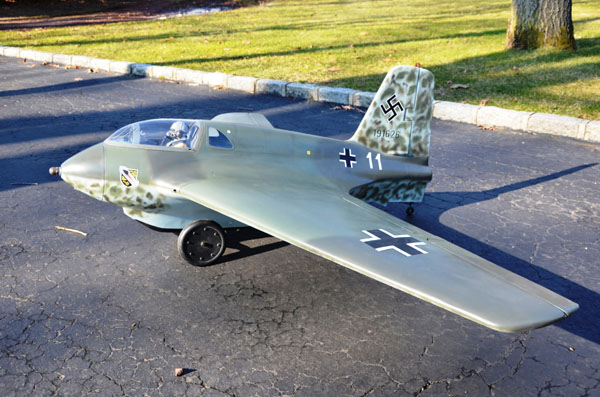 Other tactics used against the Komets were to follow them home and then strafe them after they had landed. Though well advanced of most– if not all — propeller-driven fighters of the day, the Me 163 Komet was a prime example of “too little too late” as the design did little to change the outcome of the air war over Europe.
Other tactics used against the Komets were to follow them home and then strafe them after they had landed. Though well advanced of most– if not all — propeller-driven fighters of the day, the Me 163 Komet was a prime example of “too little too late” as the design did little to change the outcome of the air war over Europe.
Text & Photos by Sal Calvagna
I built my first scale Komet around the mid-1990s from Jim Kiehl plans. It was 1:4.5-scale, had standard balsa and plywood construction and included a fiberglass nose cone and clear canopy I purchased from Joe Saitta. Spanning 82 inches, the Komet was a one-piece design and did not have removable wing panels. I powered it with a SuperTigre .90 glow engine and I was amazed by its performance and flight envelope.
In 1997, I was honored to meet Rudy Opitz (one of the original WW II Luftwaffe test pilots involved in the Me 163 Komet program). Rudy met with us at a model airplane event in Stratford, CT, as he lived nearby. We all had a great time listening to Rudy re-live his experiences at the controls of the Komet. Rudy was thrilled to watch my model Komet fly and was very happy to add his autograph to it.
Fast-forward to just a few years ago and I built another Komet, this time using a fiberglass fuselage (also from Joe Saitta) and removable wing panels for easier transportation. This time, however, I chose a much cleaner electric power system for the Komet. The electric motor fits nicely in the nose cone and is not at all visible, giving a more scale appearance to the model. I quickly realized, howver, that converting the design from glow to electric was not as easy as I had first thought.
Power and Radio System
I wanted to spin the smallest diameter, highest pitch propeller at higher rpm for two reasons: limited prop clearance and increased speed. The vast majority of the larger outrunner electric motors have low Kv ratings, which means they have more winds of thinner wire and will carry more volts at low amps to produce higher torque while swinging a bigger prop. I needed something with a higher Kv rating. So with some assistance from a couple of very knowledgeable electric gurus, I installed a Hacker A50-10L Turnado brushless motor with a Kv rating of 580. I coupled this with a Castle Creations Phoenix Edge HV 160-amp, high-voltage speed control and a 12 x 13 APC propeller. The “fuel” I chose was two Turnigy 4S, 5000mAh, Nano-Tech LiPo packs wired in series.
The power system was very easy to install and isn’t “rocket science” (pardon my pun). The fuselage is cavernous and there was plenty of room for me to install a long shelf to support the battery packs. This setup allowed me to slide the battery packs fore and aft to make adjusts to the center of gravity. The two packs and speed control are held in place with some very aggressive Velcro straps. I vented outside air through the gun holes and a small cowl vent through the fuselage and out the large rocket exhaust orifice in the tail. The radio gear in the fuselage includes the rudder servo, the receiver, receiver switch and a 1200mAh Ni-Cd receiver battery pack, which sits neatly behind the LiPo packs.
The airplane is really just a simple 4-channel RC model with the wing’s control surfaces programmed with elevon control. There are two moveable surfaces on each wing panel and I use both operating in tandem. The takeoff dolly was made from 1/4-inch music wire bent to shape and encapsulated in wood to look similar to the real McCoy. The tires are from an old baby carriage. There are two music wire pins protruding from the dolly that slide up into matching brass tubes built into the belly of the fuselage. The model taxis out on the dolly and when the aircraft rotates for takeoff, the dolly falls away.
Electric vs. Glow Power
When it comes to comparing my electric Komet to its older glow version, I can say is: Wow! The model can easily climb out of sight from takeoff and it is incredibly fast. It is also very maneuverable and can out turn any other WWII era warbird. This is by no means a surprise as the Me 163 was the fastest aircraft of the Second World War.
Flight Performance
As with all electric-powered models, the key to long flight duration is throttle management. The more throttle you use, the shorter your flight time will be, and this is definitely true with the Komet. I uploaded the flight data logs from the speed control and see that at full throttle the Komet pulls as much as 130 amps. At that rate it can drain those two 4S packs in no time. However, the Me 163 is a very unusual aircraft. Designed by Alexander Lippisch, the Komet design came from years of glider research and the final aircraft design had superior gliding capability. Just like the full size, the model also has exceptional glide performance. After a couple of high-speed passes, I usually bring the model up to altitude and just throttle back to zero power. After 30 seconds or so, I add power and repeat the process. Often half of my flight will be without any power at all.
For landing, I cut power, bleed off some excess speed and then make a very long approach. It’s a lot of fun trying to gauge the speed and rate of descent just right so that the model touches down smoothly and skids to a stop at the center of the field.
Bottom Line
My takeaway for this story is, if you don’t know what you’re doing, ask someone who does. The Me 163 has vastly improved flight performance and speed with its conversion from glow to electric power, and I would like to give a lot of credit for the success of the Komet project to my friends Greg Gimlick and Greg Covey who assisted me. They are both well-known and well-regarded electric power experts.
Gear Used
Radio: Futaba 7C 2.4GHz transmitter; 1200mAh Ni-Cd receiver battery pack; five S3010 servos (futaba-rc.com)
Motor: Hacker A50-10L Turnado (hacker-motor.com)
Battery: Two Turnigy 4S, 5000mAh LiPos
Speed control: Castle Creations HV-160 (castlecreations.com)
Charger: CellPro 10XP (revolectrix.com)



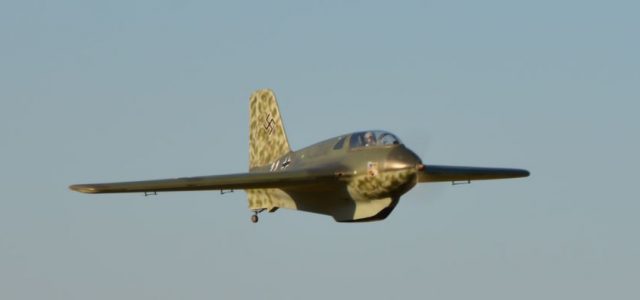
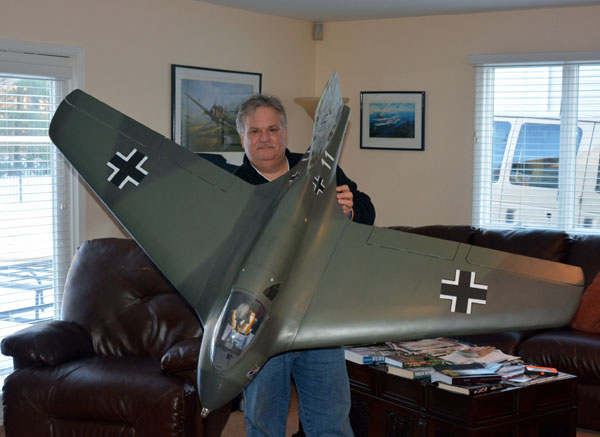

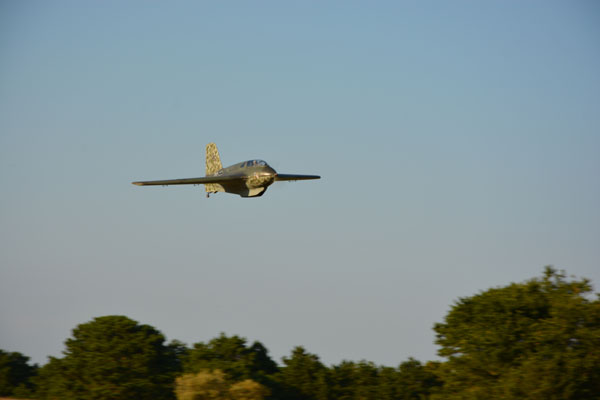

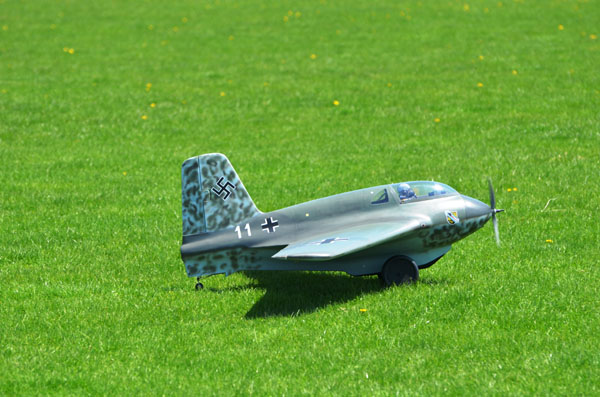

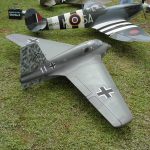
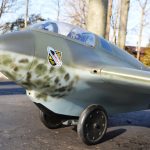
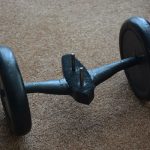


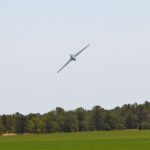
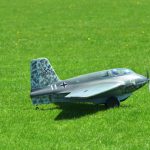

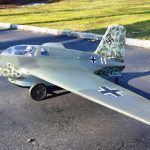
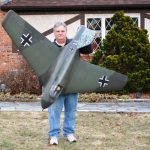
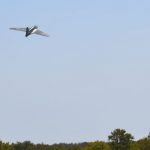
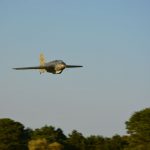
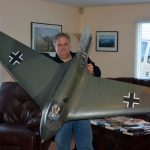


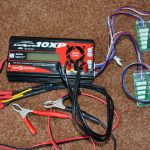






















I thoroughly enjoyed the Komet article. It is a plane that I find to be wonderful. I am thinking of building one but, I am not sure how hard it is to fly.
One of the neatest WWII aircraft. A quantum-leap ahead of everything else. At Warbirds Over Texas 2014, they had a lunchtime demo of a ME-163 that was fired off an easel with a large rocket motor. Started with a loud bang and straight up takeoff. Motor thrust only lasted a few seconds. Flew for several minutes with dives and zooms until it was out of energy and landed. Very cool presentation.
Very nice Komet!
I fly a 38” wingspan Komet (Topp Rippin) that has also been converted to electric power, with similar results. I even included the original style landing flaps, that simpify the landing approach enormously.
In our club (Gilze-Rijen, Netherlands) we start a 1/4 scale Me 263 project for which we are looking for a solid and proven wing design. This onze might be just what we are looking for, as this Komet seems to be manouevrable and gilde well. We don’t like the designs that are pitch unsensitive and don’t even fly loops or flare on the landing.
Are the Jim Kiehl plans stil available?
Thank for helping us out,
Guido
Dear Gerry,
nice article. I recently build a ME163 with 1800 mm wingspann and want to power it as well by an electric Motor. I wonder if you can give me more data to your aircraft, powered with the Hacker. Which scale is it and what was the TOW?
Many thanks
Regards
Robert (from Germany)